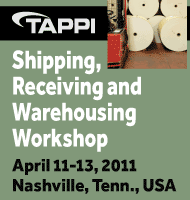 |
||||||||
| February 9, 2011 | ||||||||
| New fully enclosed slitter holders improve winding safety and cut quality. |
 |
|||||||
| · www.tappi.org · Subscribe to Ahead of the Curve · Newsletters · Ahead of the Curve archived issues · Contact the Editor |
Determine Carbon Footprint through Life Cycle Analysis
Liska says that Verso tries to promote its sustainability in the broadest
terms possible as different customers have different concerns. "Price
and quality seem to be at the top of the list of what our customers
want. But after that, sustainability aspects become important," he says.
While sustainability may become an expectation, how well you deliver
it can be a differentiator."
THOUGHTS ON RECYCLED CONTENT For years the use of recycled content for magazines and catalogs has
been quite small compared to its use in other paper grades, notes Liska
who says that to increase it dramatically probably isn't worth the effort.
"We produce high quality magazine and catalog grades which require
high brightness pulp in order to meet the final brightness requirements.
It is difficult to find high quality office grade recycle that meets
our quality standards," says Liska. "It is also becoming more apparent
that there often really isn't an environmental benefit for recycled
content in our higher grades. A life cycle analysis we've recently done
with National Geographic (see the upcoming March/April issue
of Paper360° for the complete article) has shown that using
recycled content doesn't improve the carbon footprint, and in some of
our other studies we've even seen an increase in carbon emissions as
a result of the use of recycled content."
Liska feels that recycled content is better used for grades such as
containerboard and boxboard where there are no brightness level requirements
and where contaminants in the recycled content can be better tolerated.
And as there is less need for processing, cleaning and deinking, the
resulting carbon footprint is lower.
"Publishers have been pressured by environmental groups to use more
recycled content, so this is something we've offered for many years.
But our sale of paper containing recycled content has gone down in the
last three years. I think a lot of it has to do with the carbon footprint
we've been working on. As publishers begin to understand and recognize
that recycled content may not be appropriate for their sheet--and they
have life cycle analyses to back it up--they can go back to the environmentalists
and say that what they are asking for isn't really going to result in
an environmental improvement."
Environmentalists then argue that using recycle helps keep paper out
of landfills. "This is a better argument than to save trees (which isn't
really a relevant concern in the U.S. anymore due to the high level
of sustainable forestry practices)," claims Liska, "but we don't have
a lot of paper going to landfill. Everything being recovered is essentially
being recycled here in the U.S. or exported. So this impression that
using paper with recycled content in magazines and catalogs saves trees
or prevents paper from going to a landfill, is incorrect."
Liska says that a more desirable objective would be to continue collecting
as much paper as possible for recycling but to use it in paper grades
that make more environmental sense. It could be argued that forcing
recycled content into magazines and catalogs is forcing it into an application
that requires more energy, more cleaning and more cost. And in doing
so, there is less recycled content available for more suitable uses,
such as containerboard, chipboard and boxboard.
"We've been able to educate our customers with a lot of lifecycle assessment
studies," says Liska. "Good science and hard facts help them make better
choices. And it is starting to show as we're seeing less paper with
recycled content being purchased. Five years ago that was portrayed
as a bad thing. Today it is okay, and it actually makes good environmental
sense for magazine and catalog papers. Many publishers are finding that
purchasing paper certified to SFI, FSC or PEFC standards can result
in promoting responsible forestry practices, which can offer the positive
environmental attributes they are seeking."
Liska warns that doing a good carbon footprint life cycle assessment
is necessary because there are calculators out there that show that
using recycled content will automatically improve a carbon footprint.
"That depends on which mill you are talking about," he says. "You can't
make general statements about whether using recycled content is good
or bad. You need to look at the specific mill, and that's where the
life cycle analysis needs to be done."
Craig Liska is Vice President, Sustainability, Verso Paper Corporation.
Contact him at: Craig.Liska@versopaper.com.
SIDEBAR:
Now that you
are Ahead of the Curve, stay there by joining TAPPI. |
|||||||
 |
||||||||


 "We
market our 'green' company rather than just 'green' products," says Craig
Liska, Vice President, Sustainability for Verso Paper Corp., a leading
North American producer of coated freesheet and groundwood papers for
publishers, catalogers, advertisers and commercial print producers. "Sustainability
is integrated throughout our entire organization."
"We
market our 'green' company rather than just 'green' products," says Craig
Liska, Vice President, Sustainability for Verso Paper Corp., a leading
North American producer of coated freesheet and groundwood papers for
publishers, catalogers, advertisers and commercial print producers. "Sustainability
is integrated throughout our entire organization."